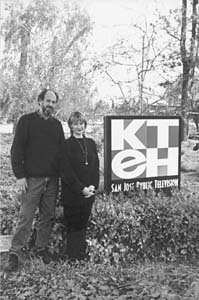 Life in the Fast Lane
Life in the Fast Lane
Silicon Valley documentary doesn't paint a rosy picture
By Geoffrey Dunn
SILICON VALLEY IS a region of profound contradictions. While its economic engine is roaring on all cylinders, the quality of life for valley residents is increasingly imperiled: traffic gridlock has become part of the daily ritual for most commuters; air and water pollution threaten public health; housing has become scarce and exorbitantly priced; there is an ever-widening gap between rich and poor; and institutionalized racism underscores a culture of growing violence and hostility.
In their illuminating, if ultimately troubling, new television documentary, Silicon Valley at the Crossroads, Bob Gliner and Christine Jensen pay tribute to the region's prosperity and entrepreneurial spirit while posing significant social and ethical concerns about its future.
Gliner, a professor of sociology at San Jose State University and the producer of more than a dozen award-winning documentaries, including Cuba: On Its Own Terms and Vietnam: At the Crossroads, and Jensen, an award-winning producer and writer with New West Pictures, examine the region's economic, educational and social structures, along with its environment, and in so doing they hold up a mirror for the community--and force us all to take a good, hard look at ourselves.
Can Silicon Valley sustain its opulent prosperity into the next millennium? Gliner and Jensen aren't so sure.
Silicon Valley at the Crossroads begins its exploration of regional life with quick talking-head portraits of young, upwardly mobile professionals. An employee at Excite Inc. compares working in the valley to "life in the fast lane."
We hear the likes of Live Pictures CEO Kate Mitchell extolling the uniqueness of the region's economy. "The money is here--the venture money--to find the good ideas," she exudes in New Age business lingo. "It's all part of an ecosystem which is part of a healthy environment for starting, creating and growing healthy companies."
The other side of paradise is articulated by an unnamed African American woman who declares in more mundane terms, "The reality of living in the Silicon Valley--it's not the everyday person making it. It's a constant struggle."
An elderly European American couple notes how they used to spend their evenings on the front porch, interacting with neighbors. Now they seek refuge in their back yard, away from the noise and bustle and crime of the streets.
We see a generation of young children spending hours a day in gridlock on their way to child-care facilities where they are raised by a string of strangers, their parents content to chase the carrot of six-figure salaries in their absence.
"There's an incongruity between the way people feel and the way they think they ought to be feeling," observes Menlo Park therapist Susan Rea. "People are burned out, they're exhausted, they're lonely. And yet they're bringing home $100,000-plus at the age of 32. ... They ought to be happy, but they're not."
A series of municipal bureaucrats from Sunnyvale to Milpitas calls for regional solutions to the valley's environmental, transportation and housing problems, but just how such solutions will be implemented amid an array of competing political jurisdictions isn't articulated. In the absence of such solutions, there's been a 230 percent increase in traffic congestion since 1995.
Nonetheless, there are occasional signs of promise in Silicon Valley at the Crossroads. There are teachers who genuinely seem to care about educating their students, social workers who seem equally dedicated to ending gang violence, and open-space advocates committed to preserving what remains of the foothills that loom over what only a few generations ago was known as the Valley of Heart's Delight.
I have only one minor quibble with the show, namely that some of the self-serving assertions made by business executives in the documentary go unchallenged.
For instance, John and Brenda Stephenson of Santa Cruz Biotechnology trumpet the egalitarian structure of their business and their "contributions to humanity," without a counter voice to challenge such claims. They would certainly be questioned by disgruntled ex-workers and a militant band of environmentalists who have battled Santa Cruz Biotechnology over the ecological degredation they charge the company with creating on Santa Cruz County's pristine North Coast.
Near the conclusion of the documentary, Mercury News publisher Jay Harris pontificates about the need for "a shared vision" for a "healthy and vital community." Just what that shared vision is, or should be, he doesn't say. His patricianesque call for "dialogue" has a hollow, disengaged ring to it--rhetoric without substance or commitment.
In the end, Silicon Valley at the Crossroads poses more questions than it answers, but the questions it raises are significant ones. As Gliner and Jensen make clear, we avoid them at our peril.
| Home |
